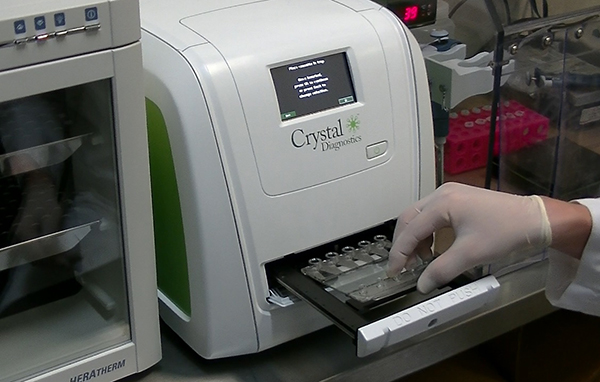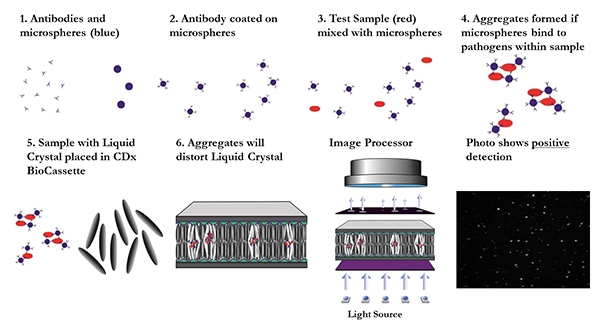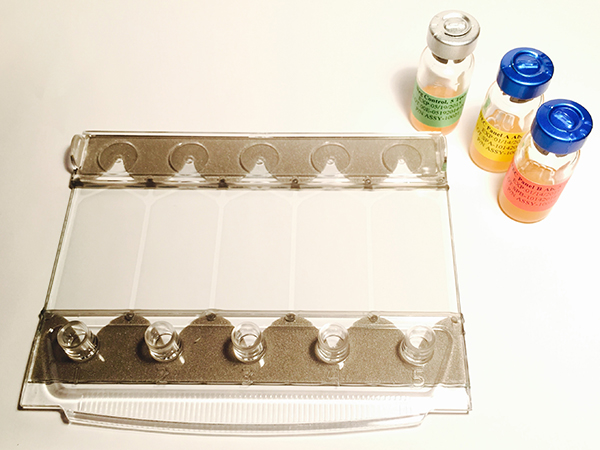 Over the last 20 years, little has changed in food pathogen testing with detection systems primarily based on culture, molecular (nucleic acids) or antibody (mostly lateral flow) systems. Although these systems have had years of field testing for performance upgrades and optimization, the basic concepts and problems of these systems remain the same. Since 2006, Crystal Diagnostics has been working to revolutionize pathogen detection through development of a liquid crystal-based pathogen detection system, a more rapid and accurate system using the selectivity of antibody capture and the signal amplification of liquid crystal. The result is the first liquid crystal-based biosensor, the Crystal Diagnostics Xpress Detection System (Figure 1).
Over the last 20 years, little has changed in food pathogen testing with detection systems primarily based on culture, molecular (nucleic acids) or antibody (mostly lateral flow) systems. Although these systems have had years of field testing for performance upgrades and optimization, the basic concepts and problems of these systems remain the same. Since 2006, Crystal Diagnostics has been working to revolutionize pathogen detection through development of a liquid crystal-based pathogen detection system, a more rapid and accurate system using the selectivity of antibody capture and the signal amplification of liquid crystal. The result is the first liquid crystal-based biosensor, the Crystal Diagnostics Xpress Detection System (Figure 1).
Crystal Diagnostics (CDx) was created in 2006 out of a research collaboration between scientists at the Northeast Ohio Medical University and Kent State University (KSU). KSU is home to the world renowned Liquid Crystal Institute and birthplace of the first liquid crystal display. Over the last 8 years of research and development, Crystal Diagnostics and its partners have secured 15 patents, and entered the commercial market with its first detection platform in 2013.
 The detection technology uses highly selective antibody-based capture paired with sensitive amplification by a liquid crystal matrix to detect pathogens in complex food types. After sample enrichment, antibodies bound to microspheres are utilized to selectively harvest pathogenic bacteria if present in the sample. When captured pathogens are bound to antibody-coated microspheres, immune complexes are formed. These immune complexes are then loaded into a proprietary BioCassette, cooled to allow alignment of the liquid crystal, and detected within 10 minutes using the high resolution optics of the Xpress Detection System (Figure 2).
The detection technology uses highly selective antibody-based capture paired with sensitive amplification by a liquid crystal matrix to detect pathogens in complex food types. After sample enrichment, antibodies bound to microspheres are utilized to selectively harvest pathogenic bacteria if present in the sample. When captured pathogens are bound to antibody-coated microspheres, immune complexes are formed. These immune complexes are then loaded into a proprietary BioCassette, cooled to allow alignment of the liquid crystal, and detected within 10 minutes using the high resolution optics of the Xpress Detection System (Figure 2).
CDx received its first AOAC accreditation for Escherichia coli O157 in raw ground beef, beef trim and spinach in 2013. A commercial unit was beta tested in the Meat Processing Career Center near Columbus, OH, from 2012 to 2013. The results from this beta testing showed rapid time to results and accuracy in an institutional meat processing setting. Additional beta testing was also conducted at Vanguard Sciences (formerly Aegis Food Testing Laboratories) in the summer of 2013 with raw ground beef from commercial, institutional, and consumer settings, and refereed against a molecular-based E. coli O157 detection system. The results showed that CDx’s one percent false positive rate is among the lowest in the industry. The total sample to result time was 10.5 hours, several hours faster than molecular screening methods.
In June of 2014, the U.S. Department of Agriculture’s Food Safety Inspection Service designated six non-O157 E. coli serogroups as adulterants in beef. Collectively referred to as Shiga toxin-producing E. coli (STEC), these foodborne pathogenic E. coli can result in severe illness or death. STEC can be present in a variety of food matrices; however, they are most often detected in beef and leafy greens. While food must be evaluated for contamination by the bacteria, there are few accredited tests available for testing in beef and even fewer for spinach and leafy greens. Of these existing tests, issues of test time, portion size, throughput, cost, accuracy and methodology are concerns.
 In 2014, Crystal Diagnostics initiated research into a faster, more accurate, simpler, and less costly STEC test. The end result was recent AOAC certification of the CDx Xpress E7 STEC kit (Figure 3), a rapid and sensitive detection system for the “Big Six” non-O157 Shiga toxin-producing E. coli (serogroups O26, O45, O1O3, O111, O121 and O145) as well as E. coli O157.
In 2014, Crystal Diagnostics initiated research into a faster, more accurate, simpler, and less costly STEC test. The end result was recent AOAC certification of the CDx Xpress E7 STEC kit (Figure 3), a rapid and sensitive detection system for the “Big Six” non-O157 Shiga toxin-producing E. coli (serogroups O26, O45, O1O3, O111, O121 and O145) as well as E. coli O157.
The Xpress E7 STEC test kit is accredited for large portion sizes (325 and 200 g of beef and spinach, respectively) and requires approximately 9.5 hours of enrichment for detection of 1 CFU of pathogenic bacteria per portion size. The diagnostic run time for a single enriched sample is only 10 minutes, and the system is scalable based on the needs of the laboratory. The shortened sample-to-results screening of food products permits those foods to be more rapidly released for sale.
“New Federal regulations require that meat facilities perform more and more testing. Being unable to distribute product in a timely manner can be an expensive proposition. With the CDx Xpress system, we are able to perform more testing and receive much quicker results, ultimately allowing us to move product much faster.” says Tony Stout, lab scientist III with the Meat Processing Career Center near Columbus, OH. Furthermore, the test is simple to use and the cost is equivalent to or better than any existing test kit.
Through collaboration with one of the many CDx university partners, the technology has been shown to be fast and accurate in other food matrices as well. Dr. Soo Ahn, assistant professor of food safety at the University of Florida Institute of Food and Agricultural Sciences, says, “We recently started using the Crystal Diagnostics Xpress system as one of our assay platforms for foodborne pathogen detection research. We have found the assay using the CDx system is quite simple. In addition, we have tested the system with food matrices outside of its validation criteria, and have had very promising results with high specificity and sensitivity that is comparable to or better than other sensitive immunoassays we use in our lab.”
Application of the CDx technology is not limited to food testing. Recent research into medical testing (such as the Ebola virus) has also shown promising results. Initial trials indicate a specimen-to-result time of approximately fifteen minutes, a fraction of the time needed for molecular-based detection systems. With the recent accreditation of its E. coli O157 and STEC test, development of additional food types and targets through university partnerships, and the beginning of research into medical diagnostics, liquid crystal technology is truly revolutionizing pathogen detection.
Curtis H. Stumpf, Ph.D. is a research scientist and Technical Service Manager with Crystal Diagnostics Applied Research Laboratory in Rootstown, OH.
Liquid Crystal-Based Detection System Revolutionizes Food Pathogen Testing in Terms of Speed and Accuracy


